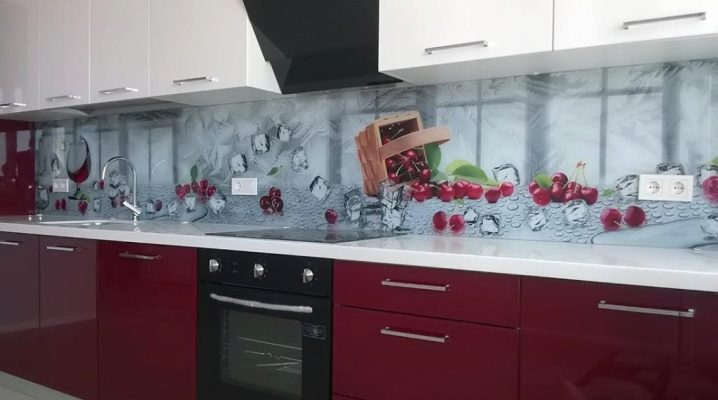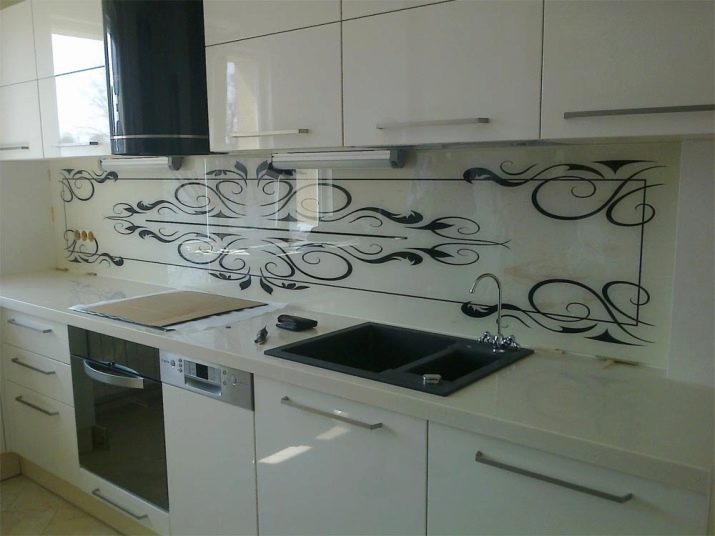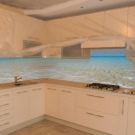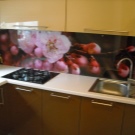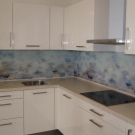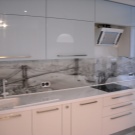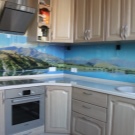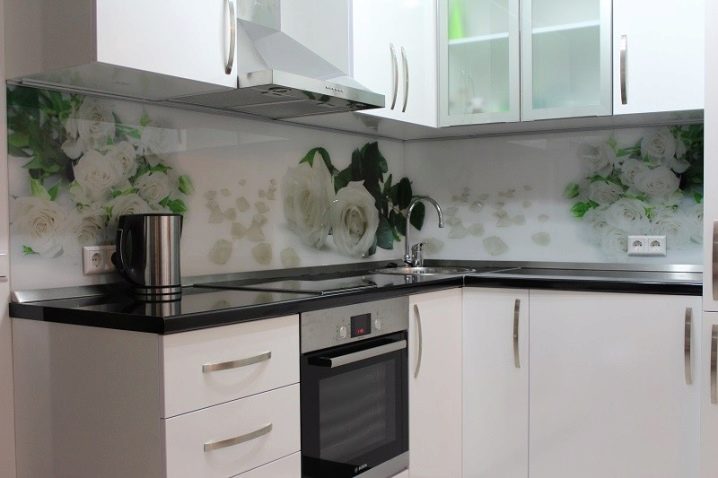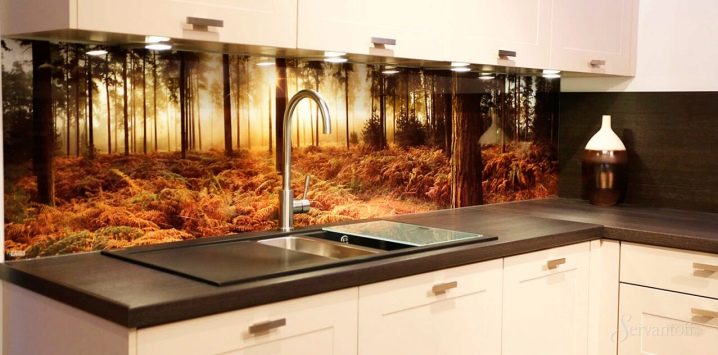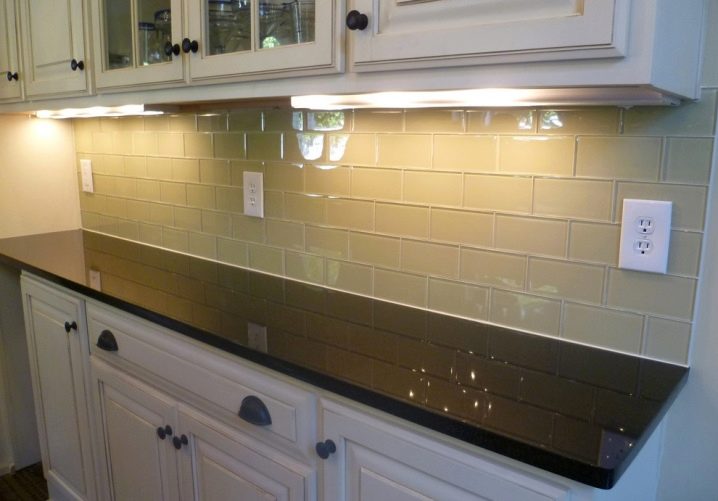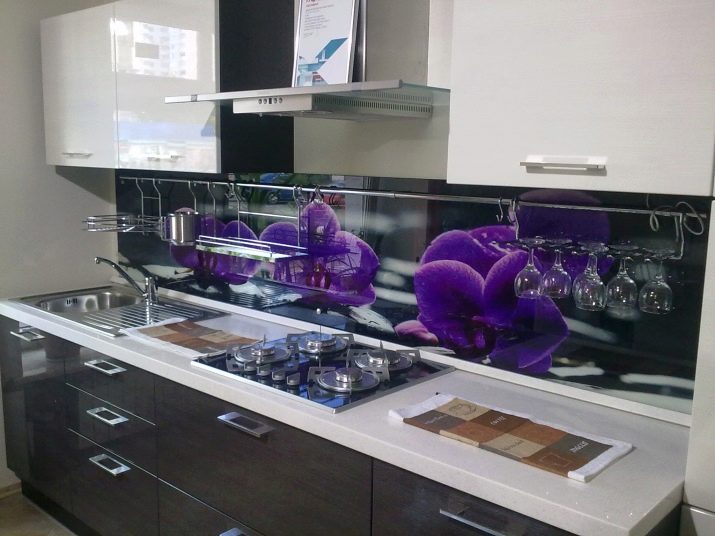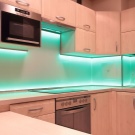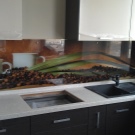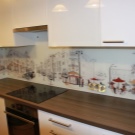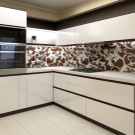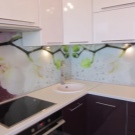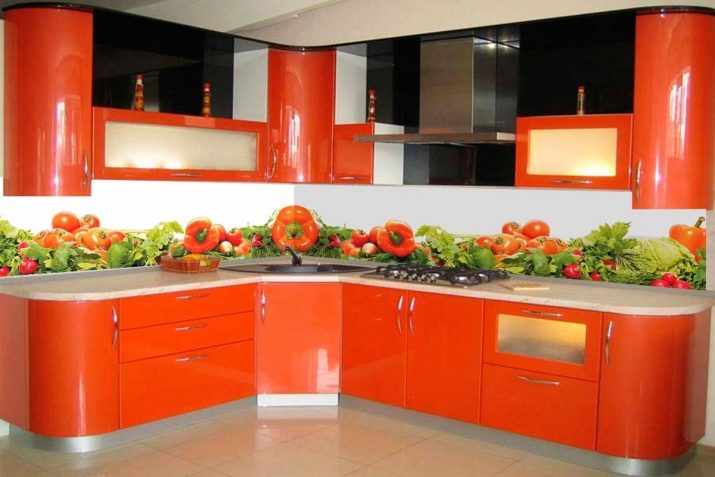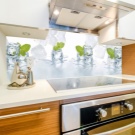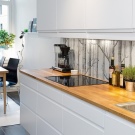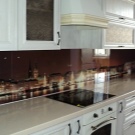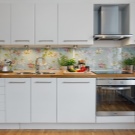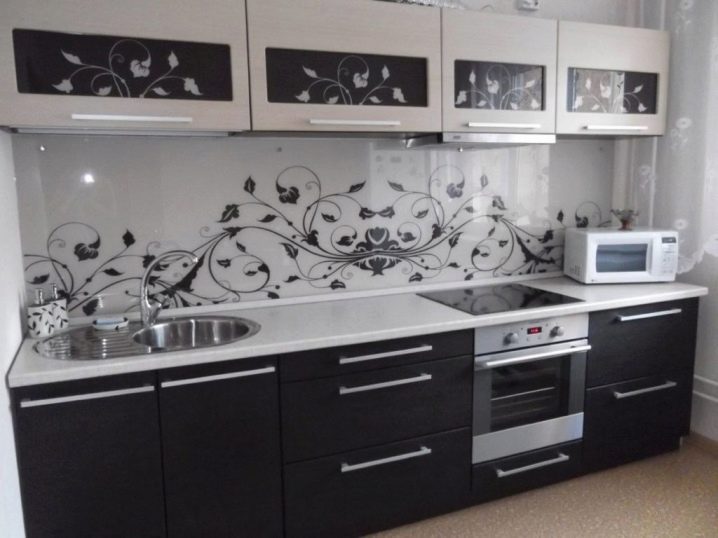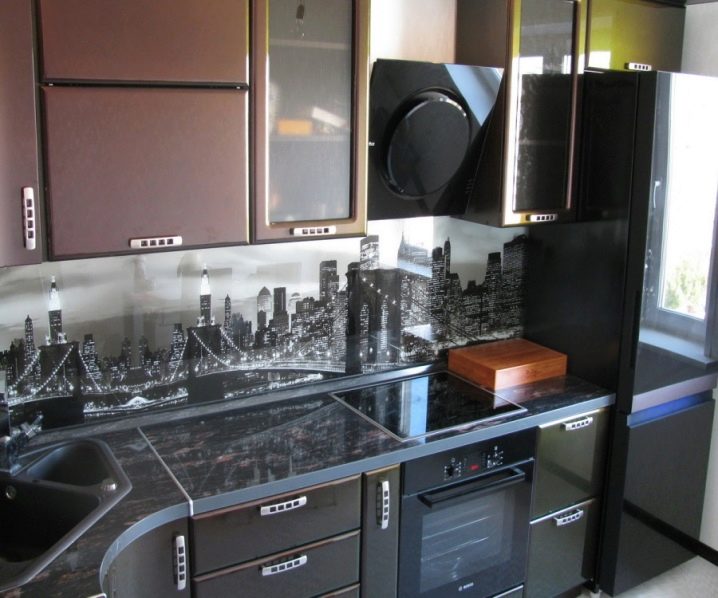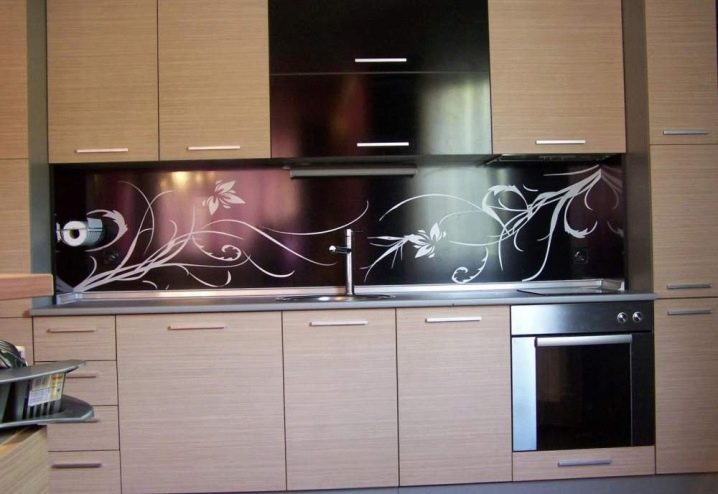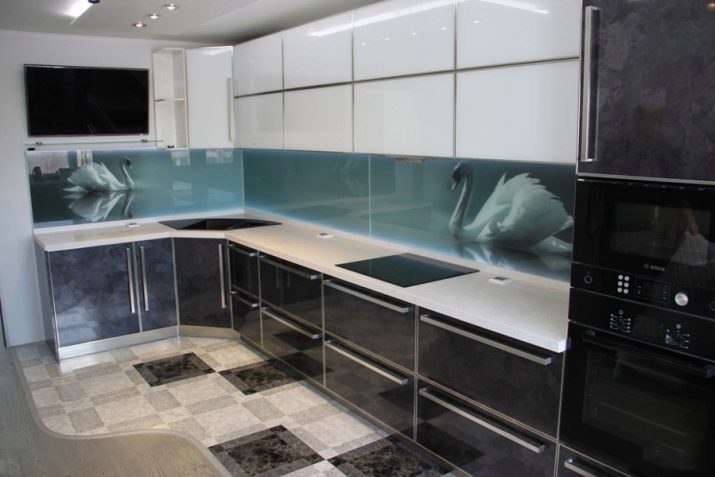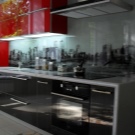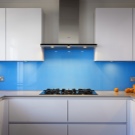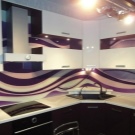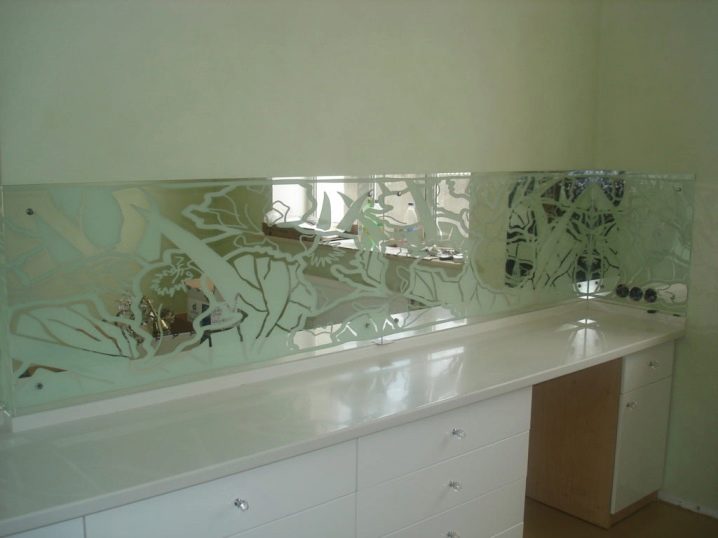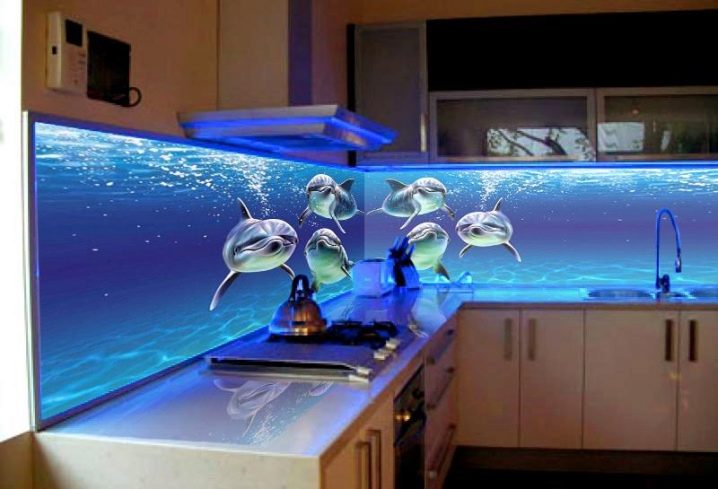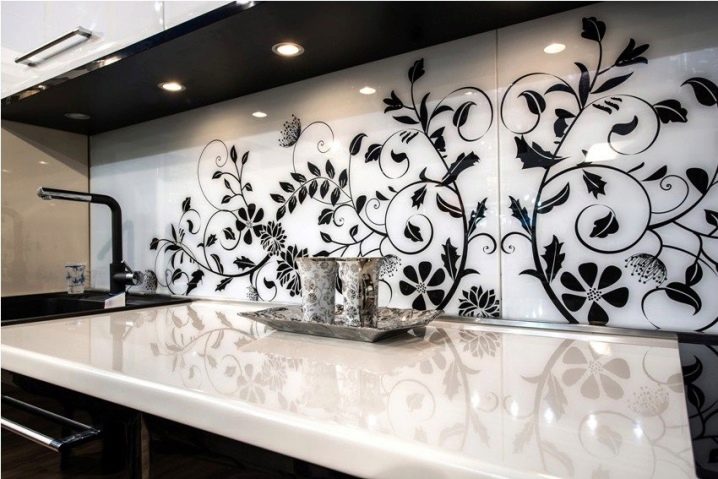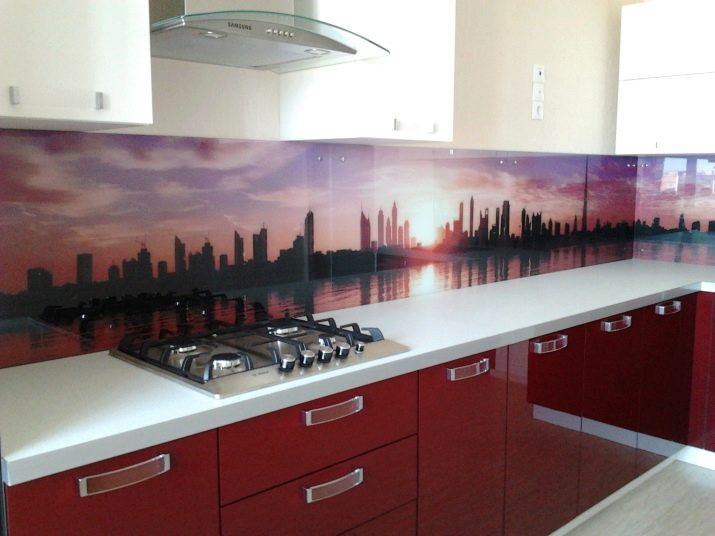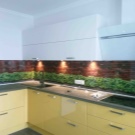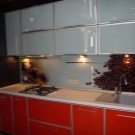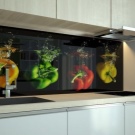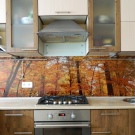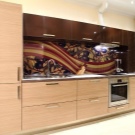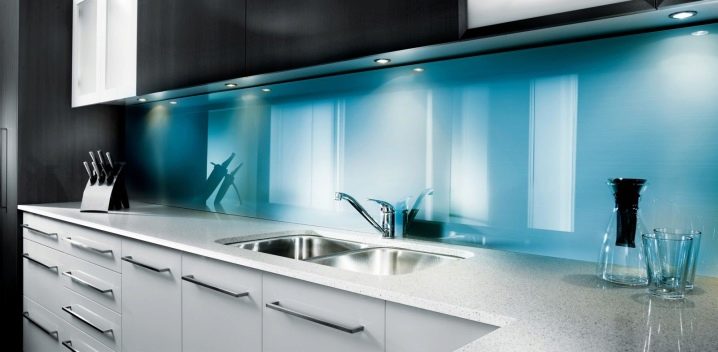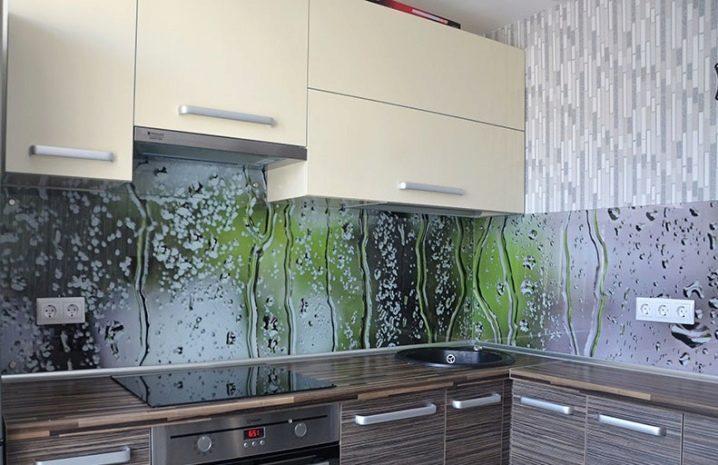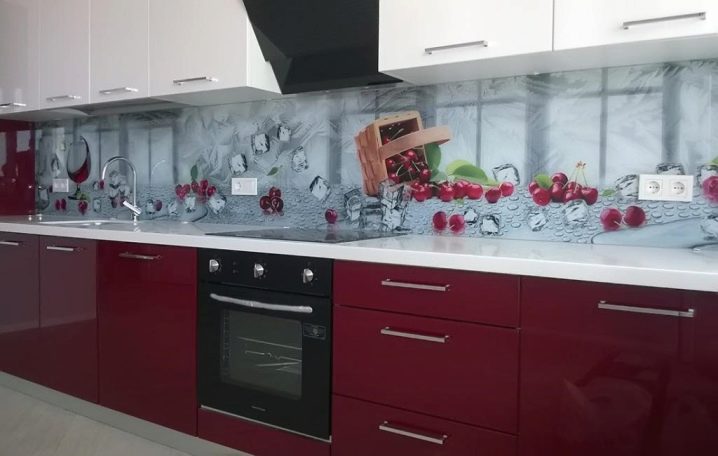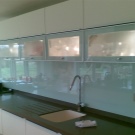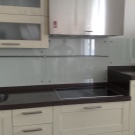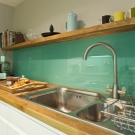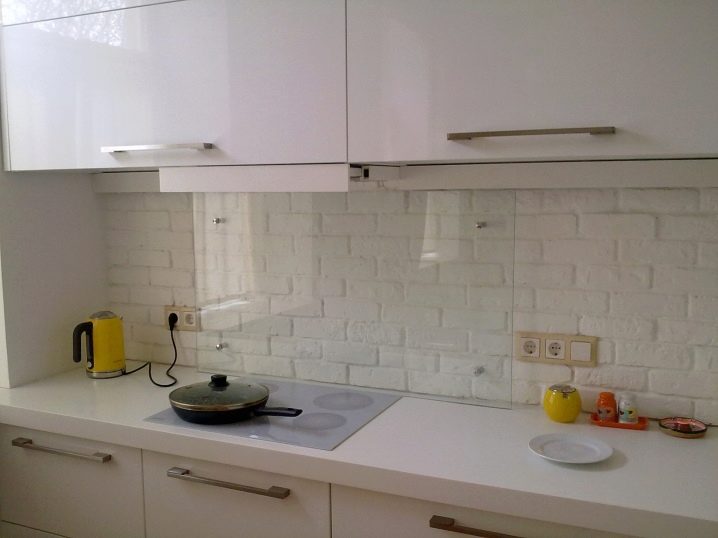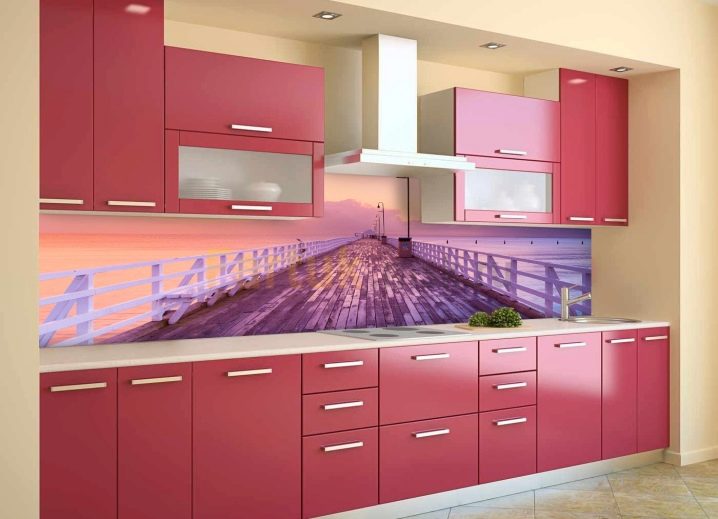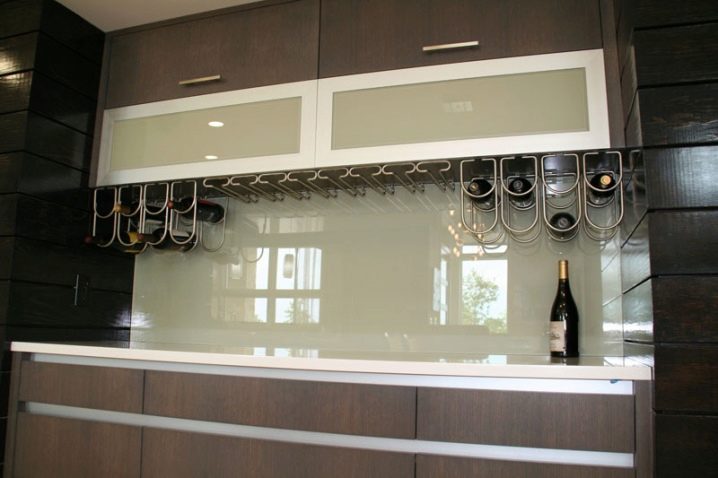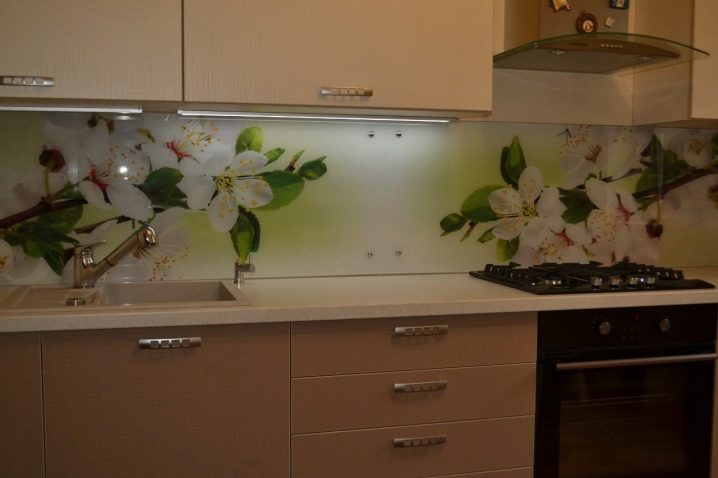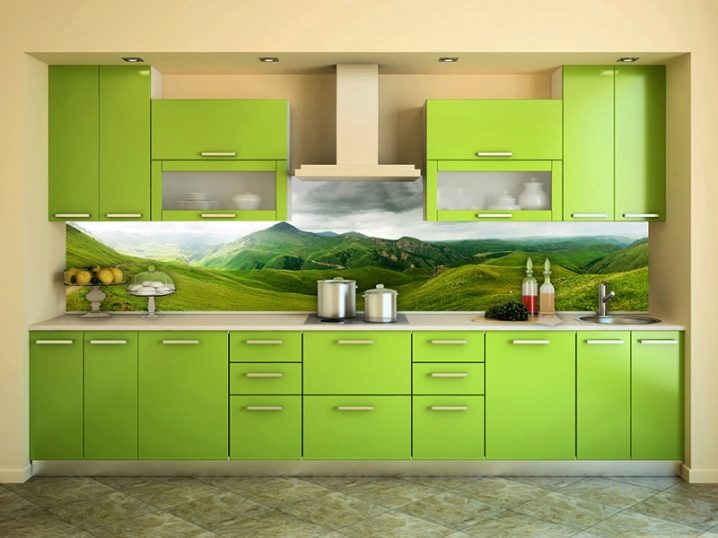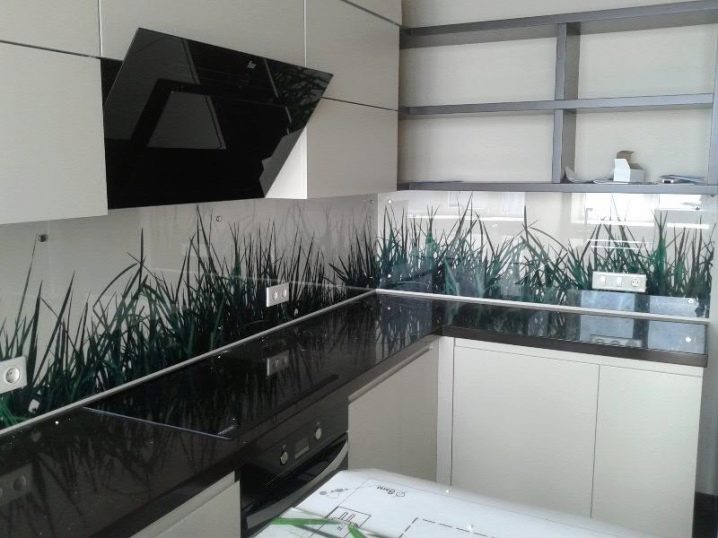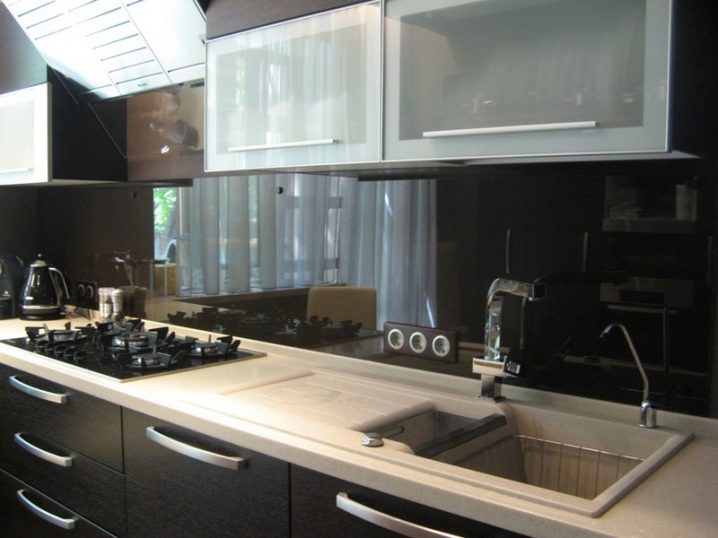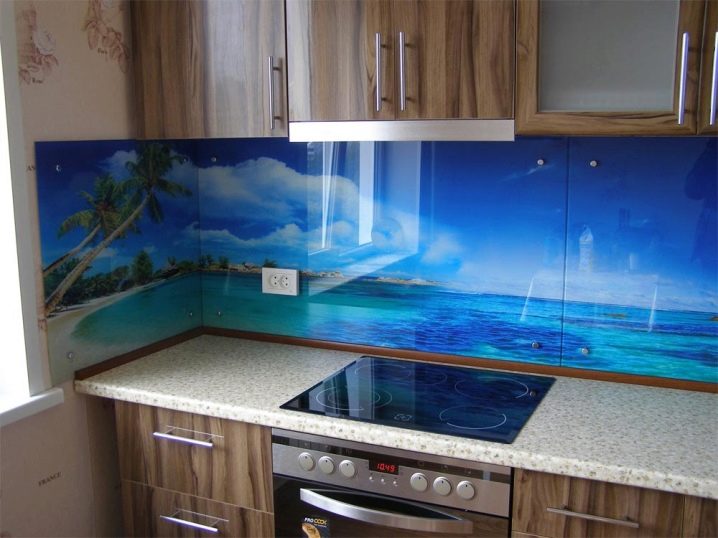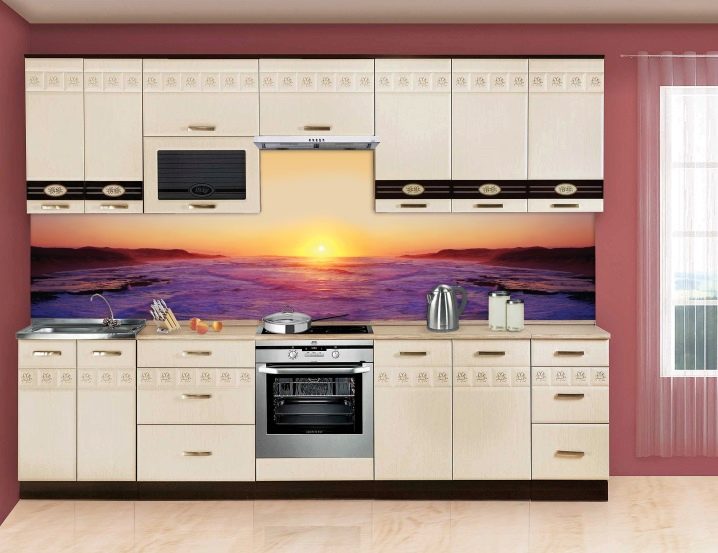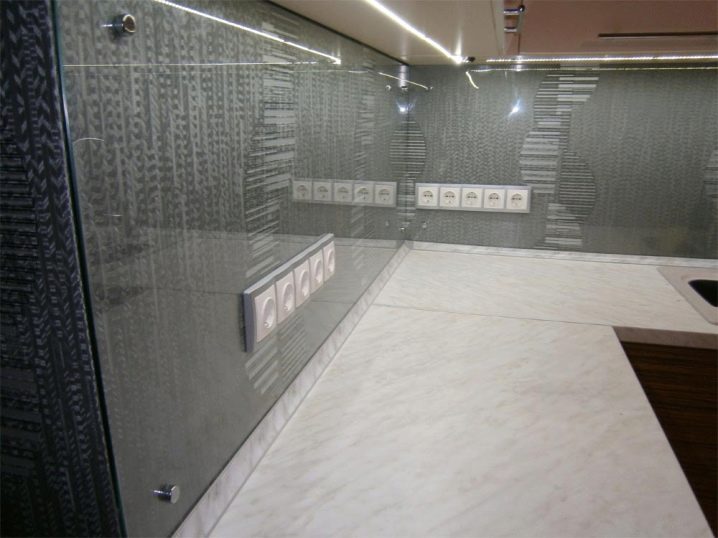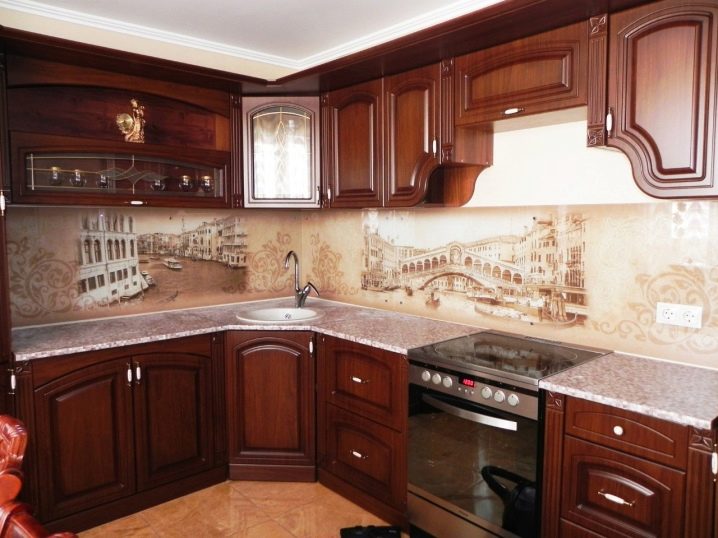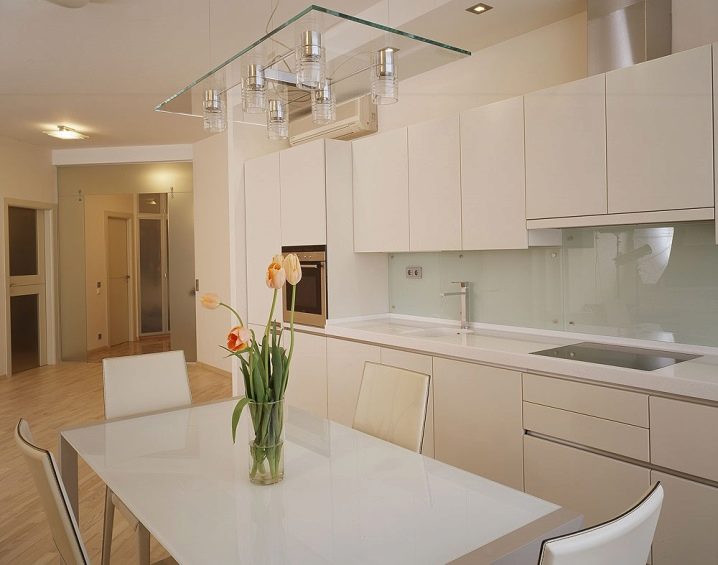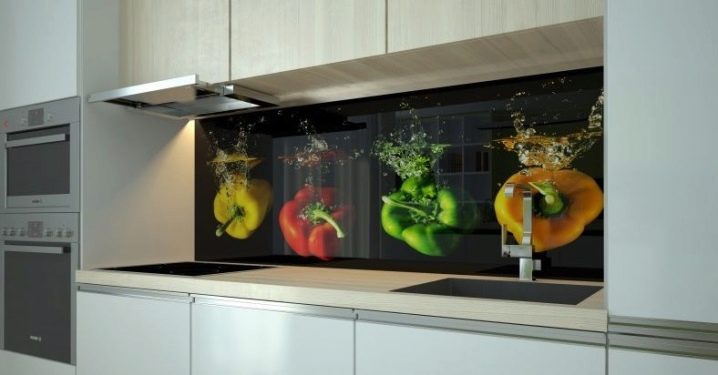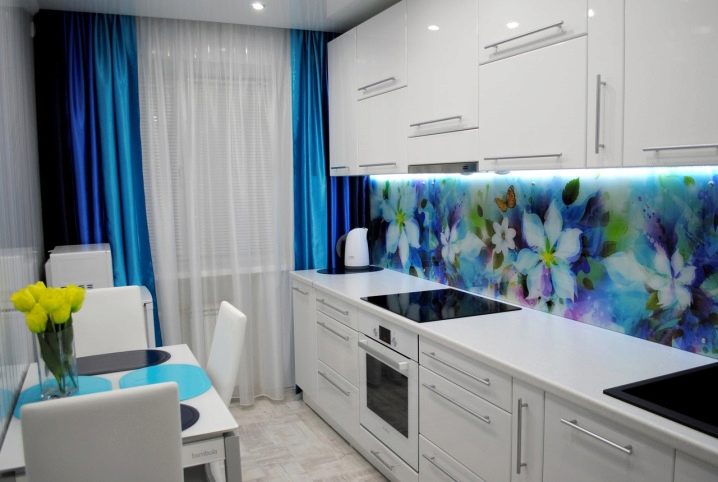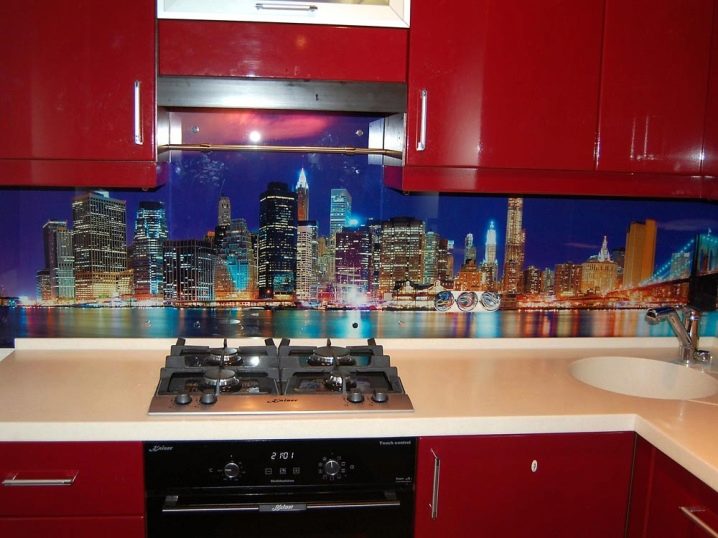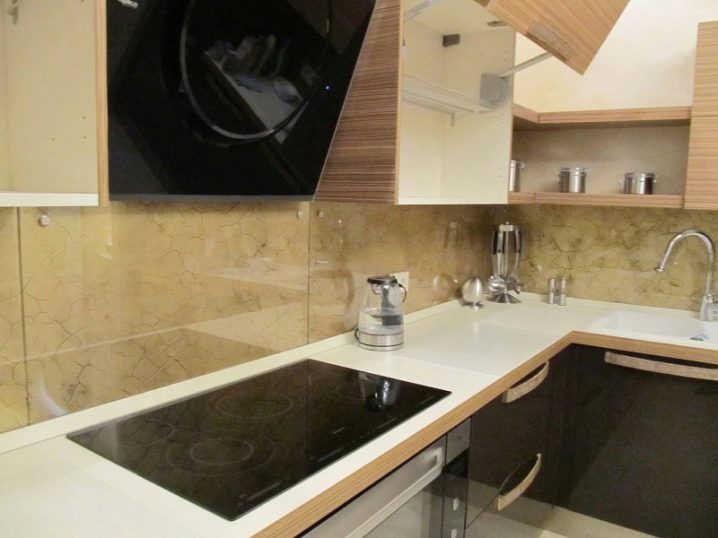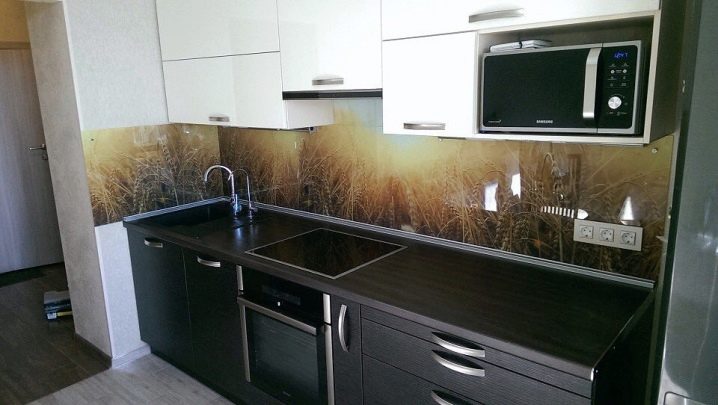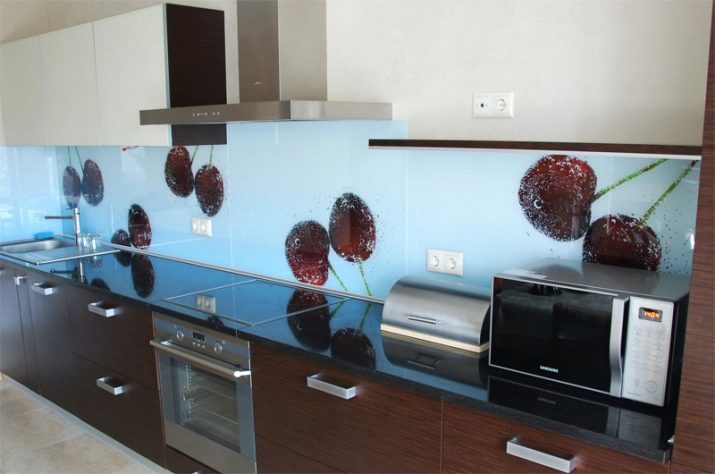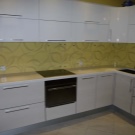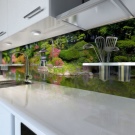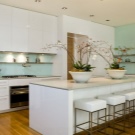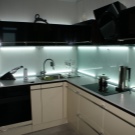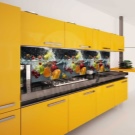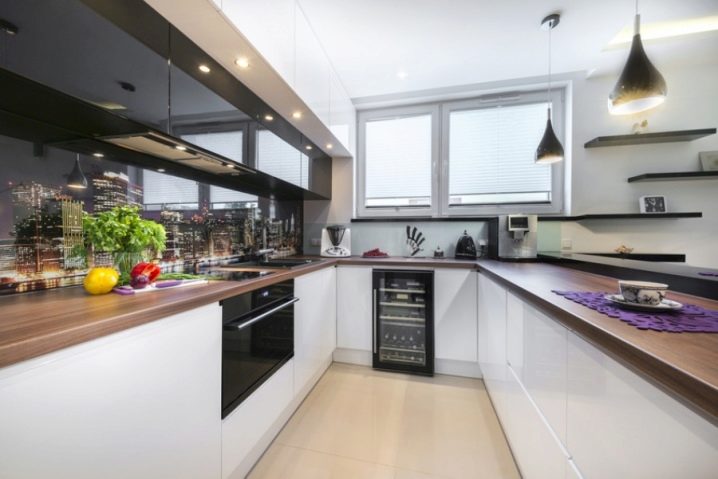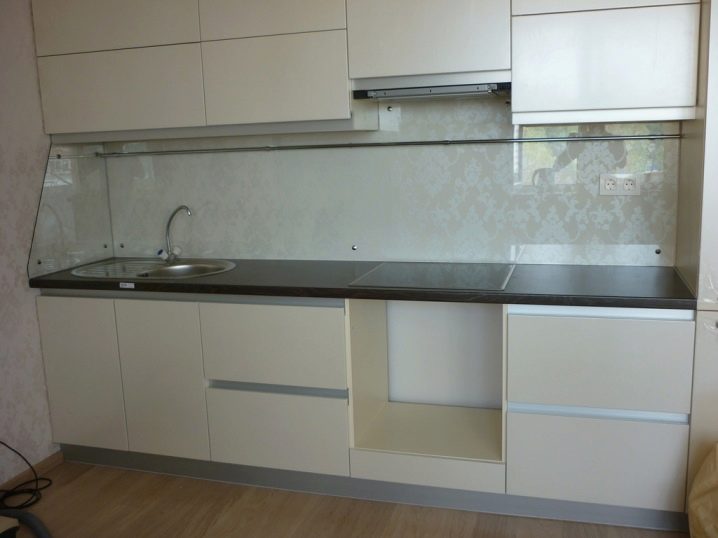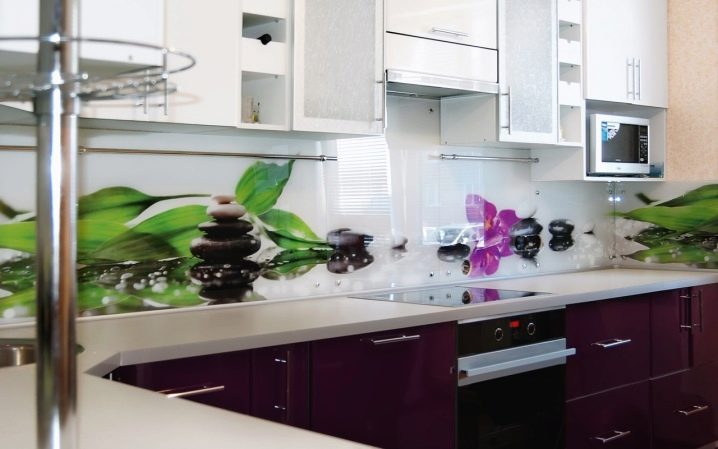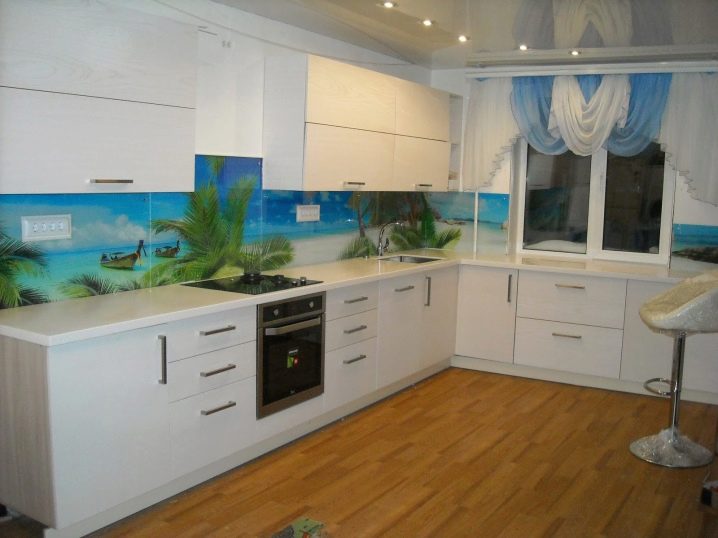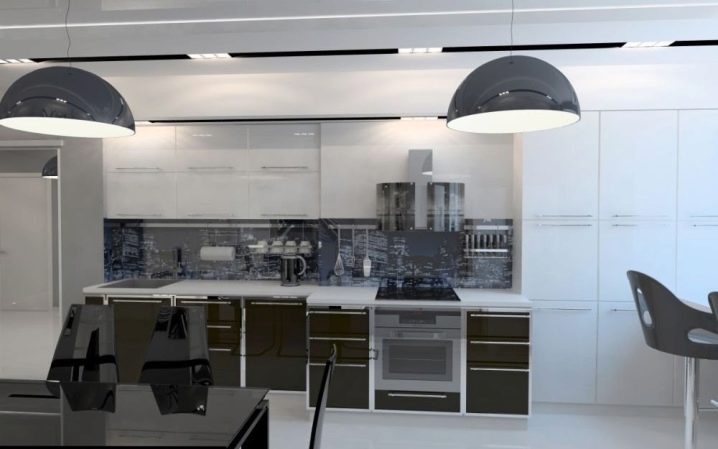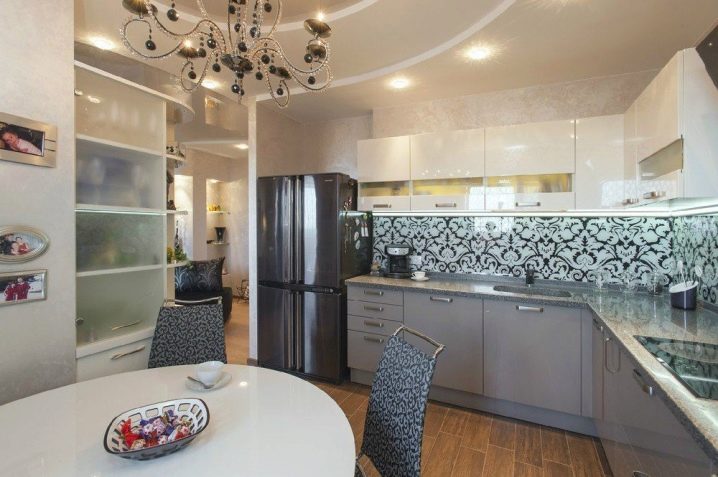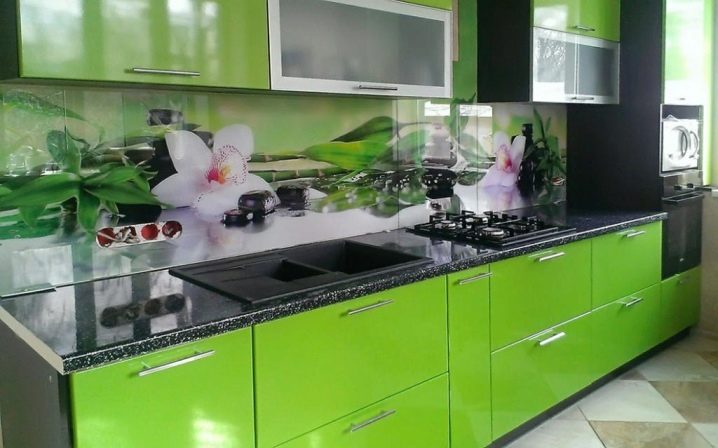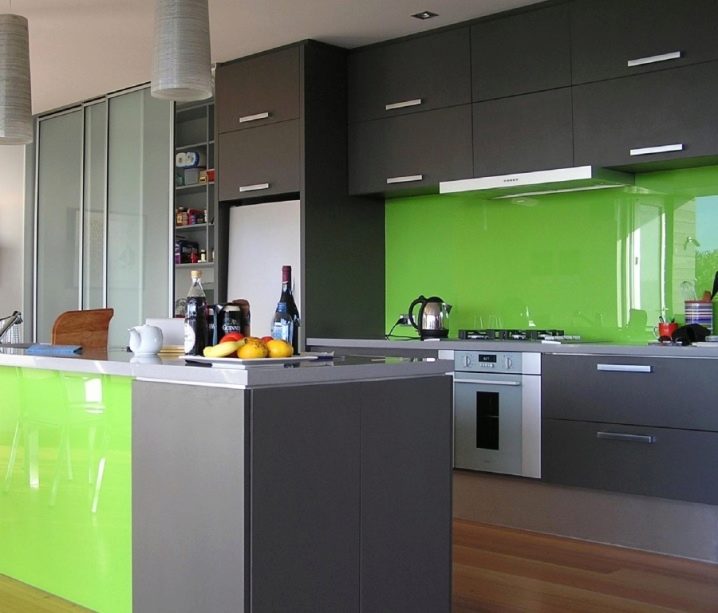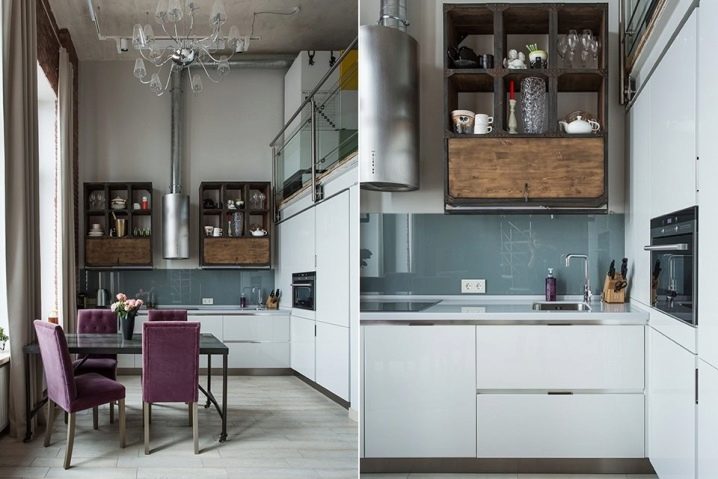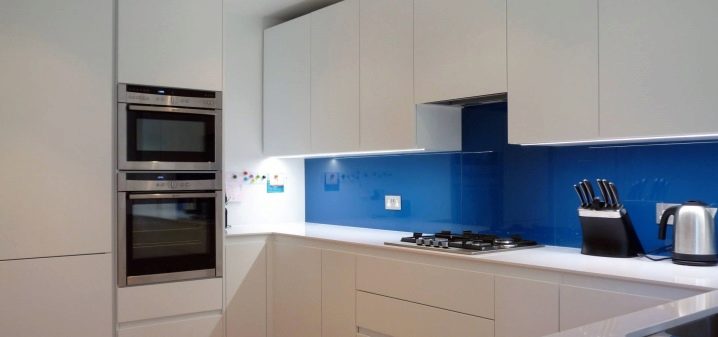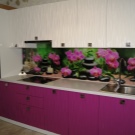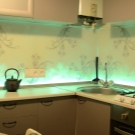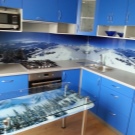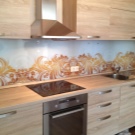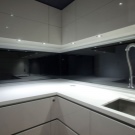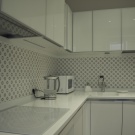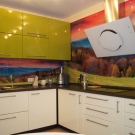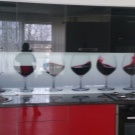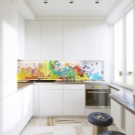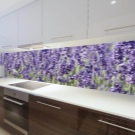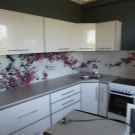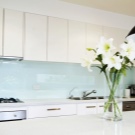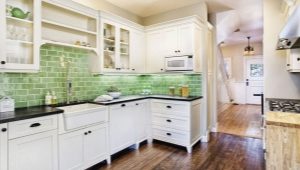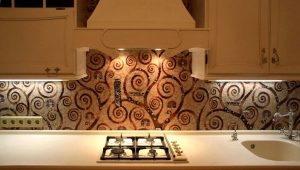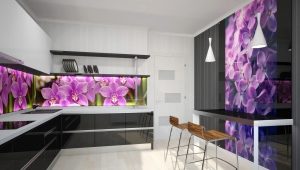Kitchen Apron
One of the modern trends used in the design of the kitchen is the use of glass instead of traditional tiles. Due to the fact that the surface of this material is smooth and has no pores, it provides increased resistance of the kitchen apron to moisture and mold. In addition, its ability to reflect light visually increases the size of the room and gives extra brightness even to a dark kitchen.
Kinds
The use of a glass kitchen apron makes the kitchen more modern, in some cases even unique. A beautiful color pattern on a glass panel or tile that shines and sparkles in various colors can turn a kitchen into a work of art and improve the atmosphere in it.
Design options for such kitchen aprons, you can choose from a huge number of different combinations available to the modern buyer. For example, purchase stained glass tiles; glass with a pattern called "skinal", or simply painted with enamel heat-resistant glass, which is called steammalit.
The color of stained glass tiles varies from simple translucent tones to iridescent and golden hues. Some manufacturers even offer glass tiles made of crystal or tiles with thin gold streaks. You can also purchase mosaic glass tiles decorated with unique hand-painted. This tile helps to create non-standard and memorable mosaics of glass or monochrome design compositions in the style of "techno".
Skinals are called panels of stalinite or triplex (tempered glass) with a high definition image printed on them. Modern photo printing method used in the production of skinali, allow you to create unique design projects. Such panels can be inserted into the gap between the upper and lower cabinets of the kitchen unit, creating a kitchen apron, or decorate the cabinet doors in the kitchen.
There are options for a single-color design of a kitchen apron with glass. It uses such modifications as:
- Stemalit, which is first painted and subsequently subjected to heat treatment in order to give strength to the material and durability of paints;
- Satinate, which is a frosted tempered glass, which can be decorated with sandblasted pattern;
- Oppite, which is also a thermal glass, but undergoes additional processing in order to give it transparency (bleached);
- Triplex, which is also called laminated glass due to the presence of a film between two glass layers;
- Light panels that have a built-in LED-backlight, which is mounted on the manufacturing stage and turns such a panel into an independent lamp;
- Plexiglass (organic glass), which is a plastic option.
Benefits
Besides the fact that the use of glass in the design of a kitchen apron adds charm to any kitchen, this material is notable for its practicality and good consumer qualities.
Advantages of a glass apron for the kitchen:
- Refractory glass is a very durable material;
- It is highly resistant to moisture and stains;
- Very easy to clean;
- Resistant to chemicals;
- It can be used to cover and protect wallpaper, or apron from other, softer materials;
- Reflects the light, so this apron will visually increase the size of the kitchen;
- Presented in a huge number of options for color, texture and pattern.
Reviews from buyers who have installed a glass kitchen apron speak in favor of this choice. In most cases, the owners almost unanimously advise the installation of a glass skinal with a pattern, but there are also supporters of a stained-glass mosaic assembled from individual tiles.
For reasons of practicality, it is recommended to install a separate panel fragment near the cooking surface or stove, since, despite the fact that heat-resistant glass is used in the production of skinali, due to temperature differences, some types of paint may detach (this does not apply to using uf printing). In this case, the fragmentary installation will allow in the future to replace the worn out site without affecting the entire canvas of the apron.
disadvantages
In addition to the benefits, a glass apron for the kitchen has some drawbacks.
The disadvantages of such use of the material as a thermal glass for the manufacture of kitchen aprons include the following points:
- The high cost of quality panels and tiles from it; cheap varieties of tiles can crack and crumble;
- In the case when the manufacture of skinali is ordered, it is necessary to carefully measure out the holes for sockets and fastenings of the rod-railing, since it is impossible to make changes to the finished skinal;
- Glass is scratch sensitive;
- When installing glass tiles or skins, special skills are needed, so you cannot do it yourself;
- Glass skinal is not a durable material, usually the manufacturer gives a warranty period.
Varieties of material
Stalin
Stalinite is a tempered, especially strong glass created in Soviet times. During production, the material is heated to a very high temperature (more than 600 degrees), after which it is cooled slowly and evenly on both sides.
After such a treatment, such a material receives high strength and resistance to external influences, therefore, sometimes the name “tempered glass” is used, by analogy with the production of hardened steel.
Also, the advantages of Stalinite include its heat resistance and thermal insulation qualities, because after such processing it is not afraid of temperature drops that can occur in the home kitchen.
In addition, Stalinite can be called safe glass, because it can break only with a very strong blow. And even in this case, the fragments will not pose a danger to others, because they will have blunt edges and will be very small.
If you put such glass on a clean white sheet of paper, you can immediately distinguish it from the usual, because stalinite, unlike simple transparent glass, will have a greenish or bluish tint.
This feature of stalinite must be taken into account when choosing enamel for applying a pattern on its surface. Also, during operation, all holes must be cut in advance, prior to the stage of its heat treatment.
Triplex
Triplex - skinali are the most expensive and difficult to manufacture. This is due to the fact that the image on such glass is made in such a way that it is protected immediately from the outside and from the inside.
In the manufacture of triplex using two methods. The first is that the film is placed between two sheets of glass, pressed and then subjected to very high temperatures. Another, more modern, is to place the glass with a layer in the vacuum chamber.Thanks to this production method, it became possible to create decorative skins from this type of transparent glass.
Thus, between two layers of glass, which due to the presence of the film becomes unbreakable, you can also arrange any decorative material. It can be fabric, leather, metal, leaves, or just a drawing is applied to the interglass film.
Thus, the advantages of triplex can be called:
- Its strength (triplex with a thickness of more than 13 mm refers to bulletproof glass);
- The fact that when breaking a triplex does not give splinters;
- High level of transparency;
- Long service life.
Negative side using triplex when creating a kitchen apron is the difficulty of working with this material and its considerable cost.
Plexiglass
An alternative to glass panels can be the use of plexiglass, which is a transparent plastic. Plexiglas is also called splashing glass or acrylic glass.
It is almost 2.5 times lighter in weight, more durable and slightly less transparent than classic glass. The advantage of this type of material can be called its flexibility and ease of processing; as it is easy to cut, polish, grind and paint.
Just as on the surface of ordinary glass, it does not develop mold and other microorganisms.
There is extrusion plexiglass and cast, between these two options there are some differences in the manufacture, but they have little effect on consumer properties. Both of these materials are used to create kitchen aprons. It is worth remembering that plexiglass can be deformed when heated, so do not place it over the stove.
Drawing an image is possible either by sticking a film on the wrong side of the skin, or by using the modern uf printing method. This method involves the use of special inks that are applied to the front surface of the material. Images obtained under the influence of uf - rays are clear and bright, because the paint is not absorbed, but remains on the surface. When caring for such an apron, abrasive cleaners should be avoided.
Polycarbonate
Polycarbonate also belongs to polymers and is a type of acrylic glass, also called ABC - plastic. It has a soft structure and flexibility, without problems cut with a jigsaw or even a regular table knife.
The drawing on polycarbonate is applied either with the help of a decorative film glued on the seamy side, or by means of UV printing. The latter is better and more convenient to use. The disadvantages of using such a material are the fact that after a couple of years, such an image will lose brightness, and the bright picture may become yellowish.
Selection tips: what to look for
For glass skinali there are restrictions on the size. Standard sizes provide that the maximum length and width of the fabric can be up to 3300 × 2140 mm. In cases where the working wall is larger and a longer apron is required, several panels are made that fit the final version. In this case, combinations of several skinals with an identical or fragmented pattern are possible, creating an overall indescribable decor.
The most suitable for the design of drawings is a glass called "optivayt." This results from the fact that this clarified and tempered glass is completely transparent. Due to the absence of a greenish tint inherent in such material as, for example, Stalinite, optivite provides accurate color reproduction of the picture.
An important technical nuance is the moment whether the drawings on the panel correspond to the holes for the sockets and fastenings for the railing, which must be provided at the design discussion stage in order to preserve the harmony and integrity of the overall picture.
It is necessary to pay attention to the thickness of the purchased glass. This figure depends on the size of the kitchen apron. For shorter skinales, for example, a length of 1 meter, the optimum thickness will be from 4 to 5 mm. If the skin is longer, then in this case it is advisable to make it from a thicker 6 mm glass.
It is also necessary to pay attention to the method of applying the pattern on skinal. The film method involves applying a self-adhesive film and the subsequent processing of skinali in a vacuum chamber. Upon receipt of the finished product it is worth paying attention to whether the film lies flat and if bubbles have not formed under it.
The way of ultraviolet printing consists in applying special ink and the subsequent processing of uf - rays, it has no pronounced "pitfalls". For complete confidence in the result obtained, it is worth making a preliminary color proof in the workshop.
It is not recommended to take measurements under the skin itself.Since it is necessary to order the manufacture of a glass panel in a special workshop, it makes sense to use the services of this workshop already at the measurement stage. This will avoid discrepancies when creating skinali, because the permissible error in this production is only 1mm.
Wall mount options
An apron made of skinales is installed after the kitchen set is fully hung.
Installation of the finished glass panel must be made on a flat and smooth surface of the wall so that the glass does not crack. It is possible to fix a skin on top of a wallpaper or even a tile, if it lies flat. In the case when a single panel is installed, the kitchen owner is quite capable of doing this work himself.
There are two types of mounting skinali on the surface of the wall. In the first case, the fixation is carried out on the "liquid nails" or glue. It is important that the wall is smooth and dry, otherwise it is impossible to secure the skin. This option is suitable for light constructions made of acrylic glass or polycarbonate.
For heavier materials, fasteners are used with the help of metal parts: hooks or bolts.Mounting with hooks does not require the creation of through holes in the glass, plate hooks press the glass and are almost imperceptible. In this way it is convenient to fix the edges of the panels in case of their joining.
To fix the skinal with the help of bolts, it is necessary to plan special holes for them at the design stage. After fixing the screw is closed with a decorative cap. With this method of installation, there is a small distance between the wall and the skin, so it allows installation of the panel even on the surface of the old tile. The most reliably skinal fastens on the bolts, but they do not always fit well into the drawing, this point is worth considering when choosing an artistic composition.
Some manufacturers offer a glass apron mount with magnets. In this case, on the inner surface of the skins and on the wall there are magnets-antipodes that can withstand the weight of the panel and are invisible from the outside. This is a very neat and clean mounting method.
Designer Tips
A kitchen apron in the form of skinali allows you to fill the kitchen with color and paint,thereby putting the finishing touch to its design. Skins of glass are usually made at the individual choice of the customer, but you can also buy ready-made images.
The overall style of the kitchen may require the use of single-colored, or even transparent skinal glass. This happens in the case when the kitchen set is saturated with bright and noticeable details, for example, it is made in the style of "baroque" or "rokail".
For kitchen furniture, made with the use of painting it is also advisable to choose a concise glass apron. This may be a monochromatic colored glass, as long as its shade is repeated in the design of the headset.
Transparent glass perfectly emphasizes the exquisite wallpaper, without creating a special emphasis on the presence of a kitchen apron, but while reliably protecting the working wall.
White glass panels are perfect for a classic kitchen, made in soothing light colors of wood without the use of textured finishes. They can also look spectacular in a kitchen with black cabinets, or dark wood cabinets.
In the case when the kitchen furniture is made in a strict design, the kitchen apron becomes the main designer trump card.Almost all modern design styles allow for the presence of multi-color interesting compositions.
Variations of the high-tech style imply the possibility of the presence in the design of the kitchen space of city landscapes, the underwater world, beaches, grasses and flowers. Especially effectively it looks in the presence of illumination on the lower edge of wall cabinets.
"Art - Deco" allows for exquisite fantasy images, art - skinal from ornaments, often made by sandblasting, which gives the images a mysterious mystery. Very profitable look in this style feed modern examples of 3D printing.
"Ethno" -style implies a variety of directions, due to its name, but within a single flow there is a sustained rigor of style decision. So, in the kitchen, made in the Japanese style, beautiful skinali with orchids fit perfectly on the working wall; and for Scandinavian cuisine, pictures of summer mountain landscapes or snow-capped peaks would be appropriate.
The style of "techno" will decorate monochromatic skins of frosted glass, excess jewelry is not typical for this direction.
The loft style welcomes gray, brown tones of natural wood or brick, covered for practicality with transparent tempered glass. Stylish and moderate.
In the style of "minimalism" will be appropriate a beautiful monochrome apron, which will refresh the strict lines of furniture and will not create overload with unnecessary details.
For each individual kitchen space, the manufacture of glass skins is an absolutely unique, measured and thought out process. However, made with a sense of proportion and taste, as well as with proper quality, such a product will certainly add a modern touch to any kitchen space.
